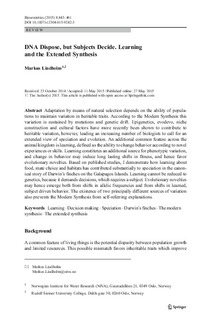| dc.contributor.author | Lindholm, Markus | |
| dc.date.accessioned | 2018-09-13T10:46:03Z | |
| dc.date.available | 2018-09-13T10:46:03Z | |
| dc.date.created | 2015-07-22T15:01:52Z | |
| dc.date.issued | 2015 | |
| dc.identifier.citation | Biosemiotics. 2015, 8 (3), 4431-461. | nb_NO |
| dc.identifier.issn | 1875-1342 | |
| dc.identifier.uri | http://hdl.handle.net/11250/2562477 | |
| dc.description.abstract | Adaptation by means of natural selection depends on the ability of populations to maintain variation in heritable traits. According to the Modern Synthesis this variation is sustained by mutations and genetic drift. Epigenetics, evodevo, niche construction and cultural factors have more recently been shown to contribute to heritable variation, however, leading an increasing number of biologists to call for an extended view of speciation and evolution. An additional common feature across the animal kingdom is learning, defined as the ability to change behavior according to novel experiences or skills. Learning constitutes an additional source for phenotypic variation, and change in behavior may induce long lasting shifts in fitness, and hence favor evolutionary novelties. Based on published studies, I demonstrate how learning about food, mate choice and habitats has contributed substantially to speciation in the canonical story of Darwin’s finches on the Galapagos Islands. Learning cannot be reduced to genetics, because it demands decisions, which requires a subject. Evolutionary novelties may hence emerge both from shifts in allelic frequencies and from shifts in learned, subject driven behavior. The existence of two principally different sources of variation also prevents the Modern Synthesis from self-referring explanations. | nb_NO |
| dc.language.iso | eng | nb_NO |
| dc.publisher | Springer Verlag | nb_NO |
| dc.rights | Navngivelse 4.0 Internasjonal | * |
| dc.rights.uri | http://creativecommons.org/licenses/by/4.0/deed.no | * |
| dc.title | DNA dispose, but subjects decide. Learning and the extended synthesis | nb_NO |
| dc.title.alternative | DNA dispose, but subjects decide. Learning and the extended synthesis | nb_NO |
| dc.type | Journal article | nb_NO |
| dc.type | Peer reviewed | nb_NO |
| dc.description.version | publishedVersion | nb_NO |
| dc.rights.holder | © The Author(s) 2015 | nb_NO |
| dc.source.pagenumber | 4431-461 | nb_NO |
| dc.source.volume | 8 | nb_NO |
| dc.source.journal | Biosemiotics | nb_NO |
| dc.source.issue | 3 | nb_NO |
| dc.identifier.doi | 10.1007/s12304-015-9242-3 | |
| dc.identifier.cristin | 1254904 | |
| cristin.unitcode | 7464,30,19,0 | |
| cristin.unitname | Ferskvannsøkologi | |
| cristin.ispublished | true | |
| cristin.fulltext | original | |
| cristin.qualitycode | 1 | |

